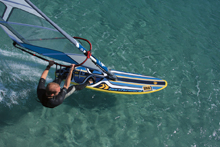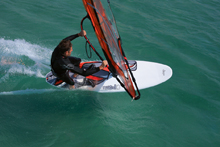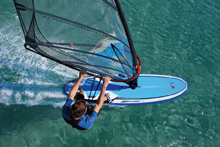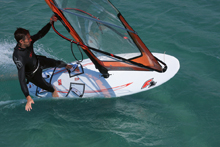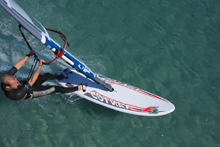Described in the brochure as ‘freemove’, which is a fair description of it, although it is very similar indeed to many other boards billed as freerides. The 113 is the middle of three boards in the Eagle range and remains unchanged in shape from last season. The range is sandwiched between the Hawk (also on test) and the Shark, both of which are also basically freeride shapes although the Hawk is billed as ‘freecarve’ due to a slightly narrower tail and higher nose lift.
Type: Classic burn-&-turn freeride with freemove, freewave leanings.
On the water:
The Eagle was the control board we used against every other board in the test to judge early planing with 6.5 and 7.5m sails, and only a couple managed to better it – just. The Eagle is one of the easier to get going in passive planing mode, and once under way settles quickly into an easy groove. It is extremely comfortable to sail with good pads and deck doming and has a lively and easy manoeuvring feel. It has a good turn of speed but is more compact, manoeuvrable and controllable than flighty. It will take up to 8.0m quite easily for good moderate wind blasting but is best with 6.0 to 7.0m sails in a more all-round role. The real beauty of the board can be found in its gybing, and there was no board on test that allowed itself to be pushed so hard and held in so well in fast turns. The relatively early and high lift nose rocker combines with the short length and good carving abilities to give the Eagle a high freewave / bump-&-jump quotient and it provides very good coastal suitability for a board of its size.
Fittings:
The pads are very comfortable, though some found them a touch smooth and therefore slippery in bare feet. The straps are excellent with a good range of placement options. The fin is fine in marginal and moderate winds, something smaller (around 34cm) is a wise investment for anything stronger.
Overall:
This was an interesting one in terms of perception. All three testers loved it, but it was only moderately popular with the guest testers. This might make it sound like the board is perhaps too technical; an ‘experts-only’ board, but actually, it’s almost the opposite. It is so easy to sail that the intermediates weren’t necessarily finding themselves challenged at their level of sailing. Whereas the competent sailors were having it a ball on it – it only lags a fraction behind the real speedsters and yet is clearly a lot more fun to throw around and gybe, feeling very small and chuckabout for its size. We think it is ideal for the mid-intermediate to advanced medium to heavyweight (70- 95kg) blaster / gyber but very suitable also for lighter to medium weight (55-70kg) early to mid-intermediates, giving plenty to grow into.

